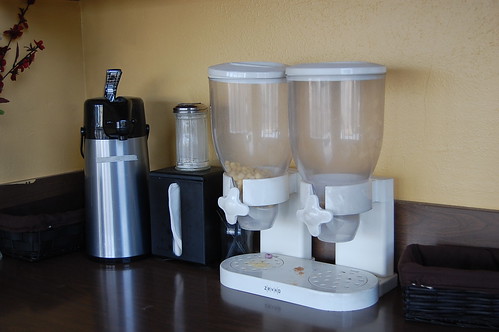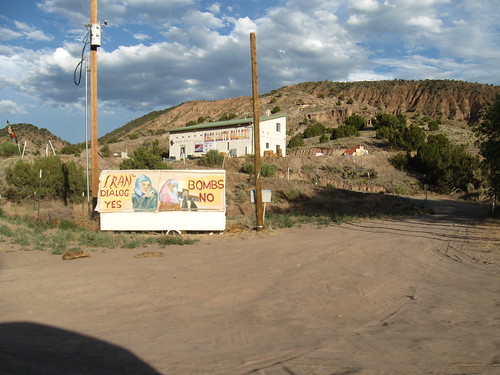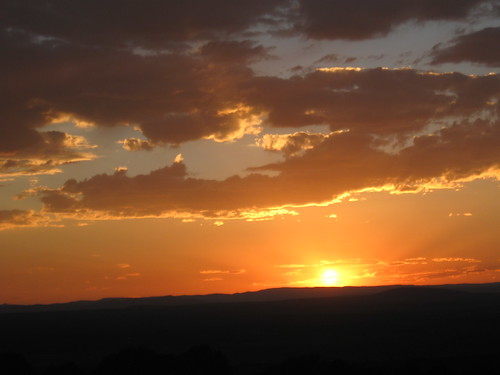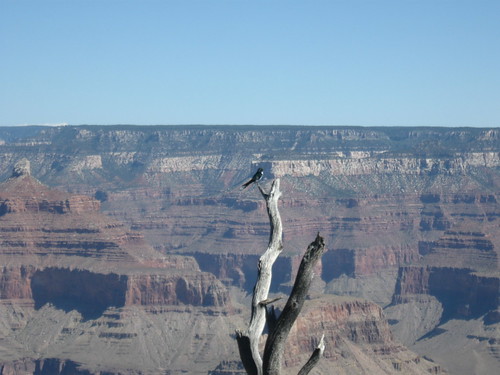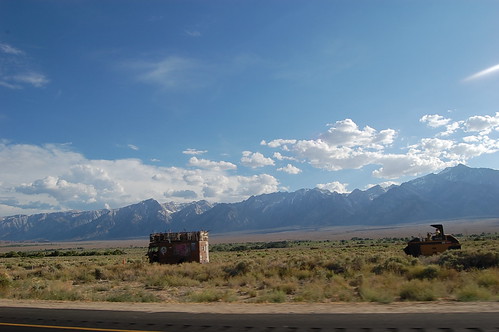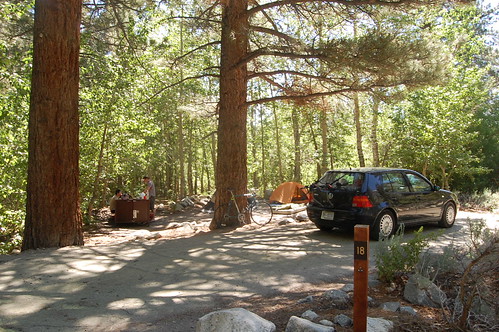 In July of this year, as part of our move to San Francisco, K and I, along with our friend J, drove from Washington DC to the West Coast. Driving across America is one of the best travel experiences I've had. America is a huge country, as wide as Australia but with geological diversity beyond that contained by our island.
In July of this year, as part of our move to San Francisco, K and I, along with our friend J, drove from Washington DC to the West Coast. Driving across America is one of the best travel experiences I've had. America is a huge country, as wide as Australia but with geological diversity beyond that contained by our island.
North America is a young continent and it feels this way, both culturally and, especially as you head West, geographically. The land bucks and meanders, evidence of the slow but epic collision between the East and West coasts, the glacial grinding of the last ice age, volcanic activity and tectonic ruptures.
And as is true in many human fields America has numerous biggest, oldest, and oddest, from 4,000 year-old trees to canyons too large to comprehend. The country has an epic vibe to it, which perfectly suits the objection of driving from one side of a continent to the other, spurred on by dreams of success and adventure.
And across this great land sprawls the America nation, ugly and garish as it often looks from the perspective of the Interstate this human culture teems with a diversity and uniqueness to mirror the continent it was forged on.
What “breakfast included” looked like at our motel in Clinton, OK
Driving South-West from Washington you're struck by how lush and bountiful the land is. It's an agrarian idyll of tobacco and wheat fields when it's not what my father calls "house farms", farmland which now sprouts only identikit McMansions, already a relic of the housing boom which produced them, ill-suited for the coming century.
Once we slipped into the Shenandoah Mountains we were treated to a different perspective, of how this all must have looked five hundred years ago; dense shady woodlands where the awnings meet in a swaying contact dance, the shrouded forest flour a soft layer of decomposing plant matter. We camped at Peaks of Otter campground which a friend had recommended. It was genuinely lovely and, on this Sunday night, only about 10% full. It was my first experience of camping in an American National Park and I was very impressed.
The camp grounds were spaced out so that even when full campers wouldn't be on-top of each other. Each plot had flat ground for one or two tents, fire pit, table, bench and a spot for a car. Everything you need. It's not the same as camping in genuinely isolated locations with no-one around of course, but for car camping on the move it's perfect.
From Virginia we moved into Tennessee where we saw the obligatory country band in Nashville before moving on to Memphis where our priorities were: 1) Gracelands (at whose camp grounds we would be staying); 2) The National Civil Rights Museum and; 3) BBQ. Given that we were camped at Gracelands we decided to strike out for the Museum first, optimistically hoping that there might be enough time to see it and get back for a tour of the Mansion. The National Civil Rights Museum is contained in the Lorraine Motel, where on April 4, 1968 Dr. Martin Luther King Jr. was assassinated as he stood upon the balcony.
 The balcony where Dr. MLK Jr was killed.
The balcony where Dr. MLK Jr was killed.
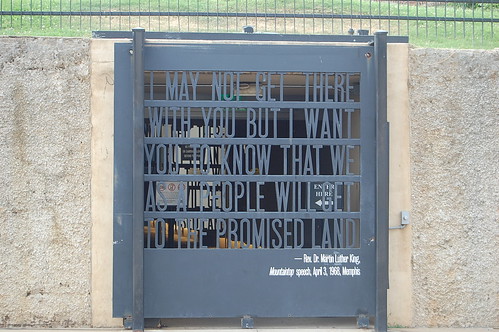 "I may not get there with you..." - from MLK's speech the night before his assassination.
"I may not get there with you..." - from MLK's speech the night before his assassination.
It's a pretty reverent place, and somewhat overwhelming to dwell on the fact that here one of the great leaders of last century was struck down, and what might have been possible had he not been. It was also, unfortunately, closed, as, it turns out, it always is on Monday's. We had a wander around the neighbourhood, stopped for a smoothie, then headed back to Gracelands, just in time to miss the final bus over the mansion by, I swear, one minute. And despite the mansion just being across the road and us already having bought tickets to the tour there was no way for us to catch up.
Resigned, we took our refund and comforted ourselves with thoughts of the delicious meal we were going to spend it on. A friend who previously lived there had recommenced Rendezvous as the “best ribs in Memphis” (I bet this is a good way to start an argument in Tennessee) and we were keen to check it out. I had begun to feel the worst for wear, even after a nap, but we were determined to make something of our visit to Memphis and so made our way downtown. No good, I tried to eat but only felt worst and had to get the ribs in a carry-out box and rush back to camp. What a disaster. Tourist fail.
 Tennessee loves them some BBQ. Just ask George.
Tennessee loves them some BBQ. Just ask George.
There was no chance to try any of this again the next day as we were picking J up from Little Rock Airport that morning. With a third driver we had a more ambitious schedule planned but this didn't stop us detouring off the forsaken interstate and through the fantastically kitsch-but-run-down town of Hot Springs. We spent one night in the best value roadside motel in Clinton, OK, then across the Texas Panhandle in a single push and onwards to Taos, New Mexico.
Numerous people in DC had warned me about driving across the Texas Panhandle. “It's so big and boring” they would say. First of all, it's not big. From Oklahoma to New Mexico was about a five hour drive. Half of Australia is roughly as featureless as Texas, four times longer, and I've driven across that four times. But more to the point, I didn't think it was boring. Or, rather, I didn't mind that it was boring. I used to really enjoy those drives from Sydney to Perth and back with my family, and the monotonous terrain was part of what I enjoyed. I've always really liked deserts from this reason. I find them really relaxing, it feels like you can unpack your brain into all that space, allow your thoughts to meander with less visual distraction.
America is almost unbelievably fertile and dense. Town after town, city after city rolls by the Interstate, wheat, corn, tobacco or some other crop usually stretching to the horizon in-between. Everywhere people. Driving across Australia you can literally drive all day while seeing only four gas stations and 16 letterboxes, standing next to driveways that stretch off further than you can see. There's nothing that approaches this desolation in America, not even in the deserts of the West Coast, and in the Eastern half of the country you're only rarely out of site of buildings unless you're in a National Park or reserve.
After Texas we headed north through New Mexico, magically arriving above our destination, Taos, just at sunset, as the last rays of the day streaked the clouds orange and made the walls of the mountains around us glow red. It was lovely.
As our eyes became accustomed to the gloom we realized that the plateau below us, upon which Taos sits, was not solid. A darker area slowly revealed itself to be a massive gash in the landscape. The Taos Gorge impressed us very much at the time, a single shark defile into an otherwise flat mesa spanned by a stark metal bridge. It seemed huge to us, although soon it would be dwarfed by much grander canyon. The desolate plain, the sudden rent in the earth, the simple old bridge, it all had a post-apocalyptic air about it and, indeed, I soon found out from a local that it featured in a scene in Terminator Salvation:
[youtube=http://www.youtube.com/watch?v=8mkmBWIUT54]
Taos itself is a lovely bohemian town filled with art galleries. The center of town featured large squares, parks and narrow streets with side walks. It was very social and walkable, people sitting in outdoor cafes, walking their dogs or chatting in shop doorways. It was the opposite of 90% of the towns we had seen, where all the action was in the strip malls on the outskirts of town, the shops pushed back from the road by the huge car parks, designed to be accessed only by driving, each mall indistinguishable from the others except for the exact composition of fast food joints and chain stores. The downtown, when we saw them, were often boarded up and near-deserted.
We took our first day off of the trip and wandered around town. It was really nice to not be in a rush and to have nowhere in particular to be. We had great margharita's and watched Lyrics Born perform a free concert in the park.
The next morning we had a look at the Taos Pueblo, a World Heritage site which had been continuously occupied for over 1,000 years and is a gorgeous maze of semi tumbled-down but still lived-in adobe dwellings. Then we were away on a beautiful and epic drive (our longest of the trip) to the Grand Canyon, through Northern New Mexico and Northeast Arizona. The scenery was incredible. At last we were seeing more and more open space, with only the occasional small town to interrupt our view. The first six hours were through steep mountain ranges covered in pines, past lakes and boulders. The second half it was red soil and tabletop Mesa's, the landscape of the classic Wild West films.
The Grand Canyon is really big. I mean, really big. Huge. You could drop a whole bunch of other big things in there and have plenty of space left. I mean, it's really epic. I don't think it would be possible to be disappointed by the Grand Canyon. The scale sends your mind reeling; it's impossible to comprehend. The gradients of colour and terraced cliff faces are stunningly beautiful and absolutely mesmerizing.
We arrived at around midnight during a full moon and first saw the canyon basked in its dim glow. Even lacking the depth and contrast of daylight it was extraordinary. There was no-one around, just us and the wind on the edge of a silent void. We camped for all of three hours, getting up at 4am to get in position for sunrise. It was an incredible experience to watch the sun peek over the cliffs at exactly 5.14am and colour slowly return to the canyon walls. There were only about a half dozen others there and we all sat in silence and watched it in awe. Truly a highlight of the journey.
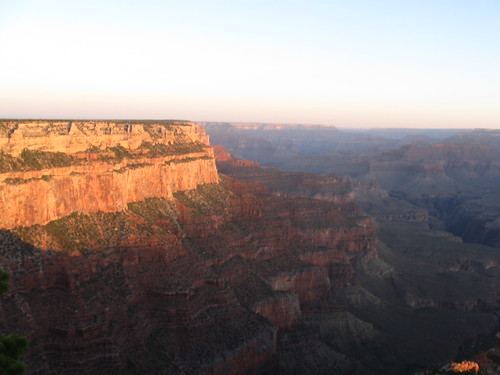 5.24am, South Rim of the Grand Canyon
5.24am, South Rim of the Grand Canyon
The Grand Canyon is surprisingly well-managed. Unlike the Niagara Falls (on the Canadian side mind you) which is a scrum of casinos and hotels right next to the main attraction, jostling for water views, and massive tour bus after massive tour bus disgorging tourists right on the spot, many of the best lookouts are only accessible by the free shuttle service run by the park, putting a cap on numbers even at the busiest periods (although creating lines at some bus stops). As with elsewhere the National Park camp grounds were well laid-out and maintained. Impressive.
From the Grand Canyon we drove to Las Vegas for a forgettable night in a casino then on for what would be the best day's drive of the trip: Reno to the Sierra Nevada's via Death Valley.
This is a drive that really sums up the incredible extremes and experiences of America, taking us past the lowest place in North America (282 ft/86 meters below sea level in Death Valley) and then, two hours later, the highest place in the lower 48 states (Mt Whitney in the Sierra Nevada range, 14,494 ft/4,418 meters). We would go within a handful of miles to the oldest organism on the planet, the 4,700 year-old Ancient Bristlecone Pine and the world's largest tree's, the 300 ft-tall giant sequoia's.
Death Valley is also where the hottest temperature was ever recorded in America, 134F/56C, in 1913. It was a mere 118F/48.5C the day we were there. It was like stepping into an oven, my mouth dried instantly and sweat disappeared almost as quickly as it could form. It was a dry, relentless heat, which sat like a blanket over the stark white desert. We experienced the heat in full by following the instructions of a sign which suggested turning the air conditioning off so as not to risk overheating the engine. I half expected a “just kidding, welcome to Death Valley” sign 10 miles down the road but it never came. The terrain alternated from folded rock hills to salt flats to sand dunes, with an oasis or two adding patches of green to the bleached landscape. It was very beautiful, and I felt thrilled to have had the genuinely new experience of experiencing such intense heat.
Coming out of Death Valley you go from below sea level, up and over a 7,000 ft pass, back to near sea level as you cross a flat valley then over another, even higher pass, through a pass in the well-named and seemingly-lifeless White Mountains only to see the Sierra Nevada's, a line of mountains all over 10,000 ft marching North-South before us, blocking all progress to the West. It's a wild and exhilarating drive, full of hairpin turns, sheer drop-offs and epic views.
We turn North, shadowing the eastern flanks of the mountains. The nearest pass to the West was 150 miles to the North, through Yosemite National Park. We spent two nights at the Big Pine Creek campground, not far from Bishop, nestled in the folds of the Sierra Nevada's. The Western slopes of the range is lusher and more famous with Kings Canyon and Sequoia National Parks alongside it. The Eastern side is in the rain shadow so the slopes are largely bare, the vegetation more hardy and modest. But looking up from our campsite to the snow caps of the mountains directly above us, an ice melt-fed stream absolutely smashing its way down the valley fold alongside us, it was more than beautiful-enough.
We had our second day off here, going for a hike, taking refreshing dips in the freezing-cold stream, playing with circus toys, reading and napping. It was very relaxing knowing we were within an easy drive of our destination and the weather was perfect, warm with a breeze by day, cool enough to enjoy the fire by night.
Finally our journey was coming to an end. J had a 2pm flight leaving from SFO and we were flying to Australia to get our new visas that very night. Even this final drive was filled with delights. Seeing more of the Sierra Nevada's on our way North, going West across Yosemite (where I saw beavers!) and crossing the agricultural middle of California, seeing grape, orange and wheat fields. Then onto a 10-lane freeway and into San Francisco we swept. We had crossed 9 states and the District of Columbia, driving over 3,500 miles in 11 days. I'm so glad I was able to do the great American road trip while I was here and see some of the parts of the country I've only ever flown over. I'd absolutely recommend the drive to anyone who has the time to enjoy it. I only wish we'd had twice as long!
You can see a larger collection of photos here.
